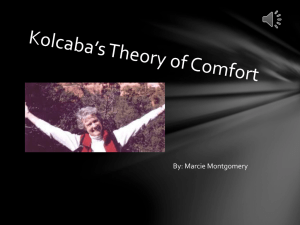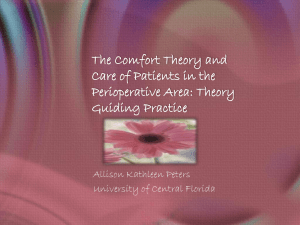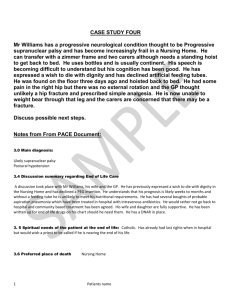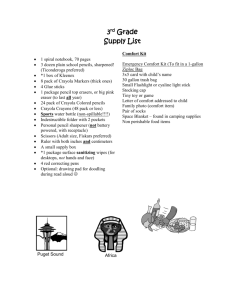Evolution of the Mid Range Theory of Comfort for
advertisement
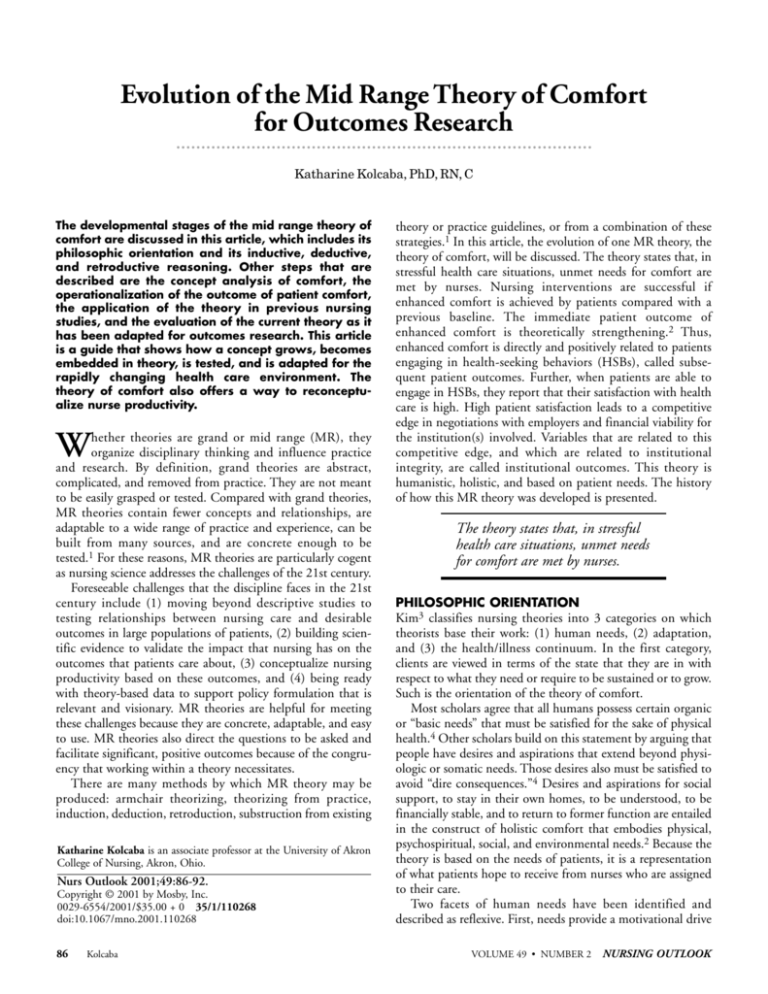
Evolution of the Mid Range Theory of Comfort for Outcomes Research Katharine Kolcaba, PhD, RN, C The developmental stages of the mid range theory of comfort are discussed in this article, which includes its philosophic orientation and its inductive, deductive, and retroductive reasoning. Other steps that are described are the concept analysis of comfort, the operationalization of the outcome of patient comfort, the application of the theory in previous nursing studies, and the evaluation of the current theory as it has been adapted for outcomes research. This article is a guide that shows how a concept grows, becomes embedded in theory, is tested, and is adapted for the rapidly changing health care environment. The theory of comfort also offers a way to reconceptualize nurse productivity. W hether theories are grand or mid range (MR), they organize disciplinary thinking and influence practice and research. By definition, grand theories are abstract, complicated, and removed from practice. They are not meant to be easily grasped or tested. Compared with grand theories, MR theories contain fewer concepts and relationships, are adaptable to a wide range of practice and experience, can be built from many sources, and are concrete enough to be tested.1 For these reasons, MR theories are particularly cogent as nursing science addresses the challenges of the 21st century. Foreseeable challenges that the discipline faces in the 21st century include (1) moving beyond descriptive studies to testing relationships between nursing care and desirable outcomes in large populations of patients, (2) building scientific evidence to validate the impact that nursing has on the outcomes that patients care about, (3) conceptualize nursing productivity based on these outcomes, and (4) being ready with theory-based data to support policy formulation that is relevant and visionary. MR theories are helpful for meeting these challenges because they are concrete, adaptable, and easy to use. MR theories also direct the questions to be asked and facilitate significant, positive outcomes because of the congruency that working within a theory necessitates. There are many methods by which MR theory may be produced: armchair theorizing, theorizing from practice, induction, deduction, retroduction, substruction from existing Katharine Kolcaba is an associate professor at the University of Akron College of Nursing, Akron, Ohio. Nurs Outlook 2001;49:86-92. Copyright © 2001 by Mosby, Inc. 0029-6554/2001/$35.00 + 0 35/1/110268 doi:10.1067/mno.2001.110268 86 Kolcaba theory or practice guidelines, or from a combination of these strategies.1 In this article, the evolution of one MR theory, the theory of comfort, will be discussed. The theory states that, in stressful health care situations, unmet needs for comfort are met by nurses. Nursing interventions are successful if enhanced comfort is achieved by patients compared with a previous baseline. The immediate patient outcome of enhanced comfort is theoretically strengthening.2 Thus, enhanced comfort is directly and positively related to patients engaging in health-seeking behaviors (HSBs), called subsequent patient outcomes. Further, when patients are able to engage in HSBs, they report that their satisfaction with health care is high. High patient satisfaction leads to a competitive edge in negotiations with employers and financial viability for the institution(s) involved. Variables that are related to this competitive edge, and which are related to institutional integrity, are called institutional outcomes. This theory is humanistic, holistic, and based on patient needs. The history of how this MR theory was developed is presented. The theory states that, in stressful health care situations, unmet needs for comfort are met by nurses. PHILOSOPHIC ORIENTATION Kim3 classifies nursing theories into 3 categories on which theorists base their work: (1) human needs, (2) adaptation, and (3) the health/illness continuum. In the first category, clients are viewed in terms of the state that they are in with respect to what they need or require to be sustained or to grow. Such is the orientation of the theory of comfort. Most scholars agree that all humans possess certain organic or “basic needs” that must be satisfied for the sake of physical health.4 Other scholars build on this statement by arguing that people have desires and aspirations that extend beyond physiologic or somatic needs. Those desires also must be satisfied to avoid “dire consequences.”4 Desires and aspirations for social support, to stay in their own homes, to be understood, to be financially stable, and to return to former function are entailed in the construct of holistic comfort that embodies physical, psychospiritual, social, and environmental needs.2 Because the theory is based on the needs of patients, it is a representation of what patients hope to receive from nurses who are assigned to their care. Two facets of human needs have been identified and described as reflexive. First, needs provide a motivational drive VOLUME 49 • NUMBER 2 NURSING OUTLOOK Evolution of the Mid Range Theory of Comfort for Outcomes Research that directs human behavior.4 Patients have implicit and explicit comfort needs that, when met, strengthen them and motivate them to perform better in therapy, rehabilitation, and learning/adhering to new health regimens.2 Second, needs are a force that is driven by social and cultural politics.4 Patient comfort needs are driven by expectations, and patients expect nursing care that is competent and holistic. An additional premise for the theory of comfort is that when nurses effectively address the comfort needs of patients, better patient and institutional outcomes are achieved, such as improved patient satisfaction, successful discharges, and financial viability of the institution. This premise was recently added to the theory of comfort through retroduction, after induction and deduction. Nurses can and should manipulate surrounding environmental features such as noise, furniture, and ambiance to enhance patient comfort. Whole person holism5 is at the core of the theory of comfort. This perspective holds that persons are in and surrounded by their environment. Nurses can and should manipulate surrounding environmental features such as noise, furniture, and ambiance to enhance patient comfort. This view is congruent with Nightingale’s6 view of the environment as an element that can aid healing and the restoration of health. Persons possess their own energy fields as do nurses. Comfort theory can accommodate the blending of these energy fields during therapeutic interactions. AN ENVIRONMENTAL FRAMEWORK: THE INDUCTIVE STAGE Induction is a form of logical reasoning in which generalization is induced from a number of specific observed instances.7 When nurses are earnest about their practice and are earnest about nursing as a discipline, they become familiar with implicit or explicit concepts, terms, propositions, and assumptions that underpin their practice. When nurses are in graduate school, they may be asked to diagram their practice, a deceptively easy-sounding assignment. Such was the scenario in the late 1980s. I was head nurse on an Alzheimer’s unit at the time and knew some of the current terms that were used to describe the practice of dementia care: facilitative environment, excess disabilities, optimum function. When I drew relationships between them, I recognized that they did not fully describe my practice. There was an important nursing piece that was missing, and I pondered about what was going on in practice to prevent excess disabilities (later naming those actions “interventions”) and how to judge if the interventions were working. Optimum function had been conceptualized as the ability to engage in special activities on the unit, such as setting the table, preparing a salad, or going to a program (and sitting through it). These activities did not happen more than twice a day because the residents could not tolerate much more. What NURSING OUTLOOK MARCH/APRIL 2001 Kolcaba were they doing in the mean time? What behaviors did the staff hope they would exhibit that would indicate an absence of excess disabilities? Should the term excess disabilities be further delineated for clarity? Partial solutions to these questions were to divide excess disabilities into physical and mental and to introduce the concept of comfort to the original diagram, because this word seemed to convey the desired state for patients to be in when they were not engaging in special activities. These efforts marked the first steps towards a theory of comfort and thinking about the complexities of the concept.8 The strategies used at this point were inductive, building from observations to a rudimentary conceptual framework of a specialized practice. Major concepts were used that were already prominent in the field of dementia care; there were a manageable number of variables, and there was a pattern that was easily detectable. Assumptions were made that truth existed in real life, that it could be captured through the senses, recorded in terms of related concepts, and verified or falsified. Thus, a “framework for dementia care” was developed and presented at a gerontologic conference, published, and opened to scrutiny.8 Concept Analysis of Comfort Like most nursing conferences, the feedback that ensued was thoughtful and thought-provoking. One observation from the audience was that the framework was applicable to many nursing settings and did not have to be limited in its scope to dementia care. But the major directive that emerged was to begin an analysis of the concept of comfort, a necessary step when developing new conceptual linkages. The concept analysis began with an extensive review of the literatures about comfort from the disciplines of nursing, medicine, psychology, psychiatry, ergonomics, and English (specifically Shakespeare’s use of the concept of comfort and the Oxford English dictionary, which traces origins of words). In nursing, a rich historic record of the use of comfort was found in Nightingale’s Notes on Nursing,6 in old and new textbooks, and in the writing of nurse theorists. Comfort was cited frequently, but not defined. Its uses were varied but not clarified. In its many forms, it could be a verb, noun, gerund (comforting), adjective (comfortable), process or outcome, and past, present, or future tense. The next 2 years were spent organizing the findings, concluding with 3 technical senses of comfort used currently in nursing. Those were relief, ease, and renewal. The article was published in 1991.9 A second pivotal nursing conference provided the stimulus to begin thinking about how to operationalize comfort. When the concept analysis of comfort was presented, the audience asked, “Why make comfort so complicated?” Responses to this question addressed the need to define major disciplinary concepts and to conduct research about what makes patients comfortable, why make patients comfortable, and how do nurses know if their interventions (or comfort measures) worked. Comfort’s complexity was noted to be a strength, and discussions about the concept produced new insights. The most important new insight was that comfort needs occurred in both physical and mental contexts of human expe87 Evolution of the Mid Range Theory of Comfort for Outcomes Research Kolcaba Figure 1. Taxonomic structure of comfort.Type of comfort: Relief, the state of having had a specific need met or mediated. Ease, the state of calm and contentment. Transcendence: the state in which one rises above problems or pain. Context in which comfort occurs: Physical, pertaining to bodily sensations or functioning. Psychospiritual, pertaining to bodily to internal awareness of self, including esteem, concept, sexuality, and meaning in one’s life. Enviromental, one’s relationship to a higher order or being. Social, pertaining to interpersonal, family, and societal relationships, including financial. Reprinted with permission from Blackwell Science, Copyright © 1994 Blackwell Science. Kolcaba KY. A theory of holistic comfort. J Adv Nurs 1994;19:1178-84. rience. These aspects of comfort could be arranged on a grid. The grid would be helpful for assessing all aspects of comfort, designing interventions where indicated, and generating items for questionnaires about patients’ comfort. Two other suggestions were incorporated at that time: (1) to change the term renewal to transcendence, as used by Paterson and Zderad,10 and (2) to conceptualize mental and physical comfort as a more holistic schema. After a thorough literature review on holism in nursing, the present taxonomic structure of comfort was published in 1991 (Figure 1).11 The most important new insight was that comfort needs occurred in both physical and mental contexts of human experience. Operationalization Comfort was defined theoretically at this point as “the state of having met basic human needs for ease, relief, and transcendence.”11 The next suggestion was to generate a questionnaire from this grid. The general comfort questionnaire (GCQ) was developed to measure holistic comfort in a sample of hospital and community participants. To do this, positive and negative items were generated for each cell in the grid. Twenty-four positive items and twenty-four negative items were compiled with a Likert-type format that ranged from strongly agree to strongly disagree. Higher scores indicated higher comfort. At the end of 88 the instrumentation study with 206 onetime participants from all types of units in 2 hospitals and 50 people from the community, the GCQ demonstrated a Cronbach’s α value of .88.12 MR THEORY OF COMFORT: THE DEDUCTIVE STAGE Deduction is a form of logical reasoning in which specific conclusions are inferred from more general premises or principles; it proceeds from the general to the specific.7 The deductive stage of theory development resulted in comfort being related to other nursing concepts to produce a theory. To do this, Murray’s theory of human press13 was used as a framework on which to hang the nursing concepts. Three early nursing theorists had been used to synthesize or derive the types of comfort. Relief was synthesized from the work of Orlando,14 who stated that nurses relieved the needs expressed by patients. Ease was synthesized from the work of Henderson,15 who described 13 basic functions of human beings necessary for homeostasis. Transcendence was derived from Paterson and Zderad,10 who believed that patients could rise above their difficulties with the help of nurses. Because these MR theories were incorporated in the types of comfort, grand nursing theorists were considered to be incompatible with a common ground that was needed to unify relief, ease, and transcendence. What was needed was a more abstract and general conceptual framework that was congruent with comfort and that contained a manageable number of highly abstract constructs. VOLUME 49 • NUMBER 2 NURSING OUTLOOK Evolution of the Mid Range Theory of Comfort for Outcomes Research Kolcaba Image available in print only Figure 2. MR theory of comfort. Reprinted with permission from Aspen Publishers, Inc. Copyright © 1992 Aspen Publishers, Inc. Adv Nurs Sci 1992;15:1. The work of psychologist Murray13 in 1938 met these criteria. Because his theory was about human needs, it was applicable to patients who experience multiple stimuli in stressful health care situations. This was the deductive stage of theory development: beginning with an abstract, general theoretic construction and substructing downward to more specific levels that included concepts for nursing practice. Each nursing concept then could be operationalized relative to a specific research setting. Murray’s intent was to synthesize a grand theory for psychology from existing lesser psychologic theories of his time. His concepts are found in Figure 2, lines 1, 2, and 3. Because comfort was perceived by patients, it was logically substructed under Murray’s concept of “perception.” “Obstructing forces” were substructed for nursing as health care needs; “facilitating forces” were nursing interventions, and “interacting forces” were intervening variables (line 4). This was the first and altruistic part of the theory, which stated that nurses identified unmet comfort needs of their patients, designed interventions to address those needs, and sought to enhance their patients’ comfort, the immediate desired outcome. The second and practical part of the theory addressed the question? “Why comfort?” For nursing, unitary trend was substructed to health thema, which was further substructed to HSBs. HSB was Schlotfeldt’s16 concept and represented the broad category of subsequent desired outcomes. She stated that HSBs could be internal, external, or a peaceful death. Some examples of HSBs are decreased length of stay, improved NURSING OUTLOOK MARCH/APRIL 2001 functional status, better response (or effort) to therapy, faster healing, or increased patient satisfaction. PATIENT COMFORT IN OUTCOMES RESEARCH: THE RETRODUCTIVE STAGE Retroduction is a form of reasoning that originates ideas. It is useful for the selection of phenomena that can be developed further and tested. This type of reasoning is applied in fields in which there are few available theories.7 Such is the case with outcomes research that, to date, is centered on collecting large databases for selected outcomes and relating those outcomes to types of nursing, medical, or institutional protocols. Adding a nursing theoretic framework to outcomes research would enhance this area of nursing investigation because theory-based practice enables nurses to design interventions that are congruent with desired outcomes, thus increasing the likelihood of finding significant results. Significant results on desired outcomes would provide data to respective institutions about nursing’s “productivity” and the importance of nursing in the present competitive market. Murray’s13 20th century framework could not account for 21st century emphasis on institutional outcomes. However, with the use of retroduction, the concept of institutional integrity was added to the MR theory of comfort (Figure 3). Institutional integrity is conceptualized as the quality or state of health care corporations being complete, whole, sound, upright, honest, and sincere. The term has normative and descriptive components. Adding the term to the theory of comfort extends the theory to a consideration of the relationships between HSBs and institutional integrity. 89 Evolution of the Mid Range Theory of Comfort for Outcomes Research Kolcaba Figure 3. Comfort theory adapted for outcomes research. Box 1. Propositions in theory of comfort 1. Nurses identify patients’ comfort needs that have not been met by existing support systems. 2. Nurses design interventions to address those needs. 3. Intervening variables are taken into account in designing interventions and mutually agreeing on reasonable immediate (enhanced comfort) and/or subsequent (HSBs) outcomes. 4. If enhanced comfort is achieved, patients are strengthened to engage in health-seeking behaviors. 5. When patients engage in health-seeking behaviors as a result of being strengthened by comforting actions, nurses and patients are more satisfied with their health care. 6. When patients are satisfied with their health care in a specific institution, that institution retains its integrity; institutional integrity has a normative and descriptive component. Box 2. Assumptions underpinning the theory of comfort 1. 2. 3. 4. Human beings have holistic responses to complex stimuli. Comfort is a desirable holistic outcome that is germane to the discipline of nursing. Human beings strive to meet, or to have met, their basic comfort needs; it is an active endeavor. Institutional integrity has a normative and descriptive component that is based on a patient-oriented value system. The theory now predicts that when patients engage fully in HSBs, such as their rehabilitation program or medical regimen, institutional integrity is enhanced also. Institutional integrity can be operationalized as patient satisfaction, successful discharges, cost-benefit ratios, or other outcomes that are essential to institutional integrity. All of these concepts are indicators of the integrity of the institution. The definitions of underlined concepts (Figure 2) will be given; propositions that link the concepts are in Box 1, and assumptions that underpin this theory are in Box 2. This theory describes traditional nursing practice as humanistic, needs-related, and holistic. Further, it relates practice to institutional outcomes that make those nursing actions that promote soundness of health care institutions visible and 90 essential (comfort care). The concepts are (1) health care needs that include physical, psychospiritual, social, and environmental needs that arise for patients in stressful health care situations12; (2) nursing interventions, an umbrella term for commitment by nurses and institutions to promote comfort care (intentional care by nurses directed to meeting comfort needs of patients); (3) intervening variables that will affect outcomes (for example, institutions that are committed to achieving improved outcomes through comfort care must provide adequate staffing of registered nurses to meet comfort needs associated with existing patient acuity on any given unit); (4) patient comfort, defined as the immediate state of being strengthened by having needs met in 4 contexts of human experience (physical, psychospiritual, social, and environVOLUME 49 • NUMBER 2 NURSING OUTLOOK Evolution of the Mid Range Theory of Comfort for Outcomes Research Kolcaba Box 3. Evaluation of the theory of comfort 1. Concepts are specific for nursing.1 Comfort has been called the essence of nursing.19 2. Concepts and propositions are readily operationalized. The theory has been tested in many settings.20,21 The outcome of comfort is operationalized easily using the taxonomic structure of comfort as a guide for item generation.11 3. The theory can be applied to many situations. Through The Comfort Line,18 students and researchers are working with the author to adapt the theory to micro-level situations. 4. Propositions range from causal to associative. Propositions generated from the theory are shown in Box 1 and have the desired range. 5. Assumptions fit the theory. The theory is holistic and needs based and theoretically empowers patients to engage in health-seeking behaviors. Institutional integrity is an important theoretic link to outcomes research. 6. The theory is relevant for potential users of the theory. Nursing students learn this theory easily22 and apply it to practice and research. 7. The theory is oriented to an outcome that is important to patients. Qualitative research indicates that patients want, and often need, their nurses to assist them in meeting their comfort needs.19,23 8. The theory entails a nursing-sensitive outcome. A traditional goal of nursing has been to attend to patient comfort.18 Patients expect this from nurses and give them credit when comfort is delivered. Through deliberate actions of nurses, patients receive what they need and want from their nurses. This theory explicates how and why to do so. mental)2 that can be operationalized by the general comfort questionnaire12; (5) HSBs, defined as patient actions of which they may or may not be aware and which may or may not be observed that are predictors or indicators of improved health16 (categorized as internal [eg, healing, immune function], as external [eg, functional status, perception of health], or as a peaceful death; HSBs are more accurate indicator of nurse productivity than the number of patients cared for; and (6) institutional integrity (previously defined). The definition of comfort has grown from its early definition9 to one that incorporates the strengthening component of comfort, the immediate desired outcome of nursing care.2 It is this strengthening component that facilitates patients’ increased engagement in HSBs, the subsequent outcome. These subsequent HSBs, as indicators of nurse productivity, are of great interest to health care administrators because they facilitate decreased lengths of stay, successful discharges, and improved public relations when patients and families are happy with their health care. The 3 parts of the theory can be tested separately, or all concepts can be tested in one study. Path analysis can indicate which variables have direct or indirect influences on desired outcomes. Now, by linking HSBs to institutional integrity in an explicit way, outcomes research is theoretically based in nursing. CRITERIA FOR ADEQUACY OF MR THEORIES The expanded theory of comfort meets the following criteria for MR theory: (1) its concepts and propositions are specific to nursing, (2) it is readily operationalized, (3) it can be applied to many situations, (4) propositions can range from causal to associative, depending on their application, and (5) assumptions fit the theory. These are characteristics of good MR theory as described by Whall.1 Nolan and Grant17 suggested 2 other criteria if a theory is to be applied in practice: (6) it should be relevant for potential users of the theory (ie, nurses) and (7) it should be oriented to outcomes that are important for patients, not merely describe what nurses do. In addition, (8) this theory describes nursing-sensitive phenomena that are readily associated with the deliberate actions of nurses, and their productivity, and are theoretically related to enhanced institutional integrity. An evaluation of how the theory of comfort meets those criteria is presented in Box 3. NURSING OUTLOOK MARCH/APRIL 2001 UTILIZATION OF THE MR THEORY OF COMFORT Accessibility of the theory on the World Wide Web has led to many applications of the theory of comfort.18 Currently, comfort studies are being conducted with many different populations, all using the MR level to generate practice-level comfort theories for specific situations. These situations include, among others, midwifery, postpartum care, a burn unit, nursing homes, medical-surgical units, angiography, hospice, perioperative care, ambulatory surgery, osteoarthritis, and parish nursing. In its simplicity, the theory of comfort has found popularity. It is hoped that the theory also will generate outcomes research that is strengthened by being rooted in a testable nursing theory. SUMMARY The construction of Kolcaba’s theory of comfort was the result of different methods for theory development applied during different stages of the process of theory development. In review, those methods were (1) inductive explication of the components of a specific practice, (2) concept analysis and operationalization of components that were yet undefined, (3) deduction from a more general organizing theory with relocation of the main concepts, and (4) retroduction to bring to the model a concept for outcomes research. Because of the congruence of this theory with evidence-based practice, it is an example of a new orientation for theories, from an emphasis on what nurses do to an emphasis on outcomes in large patient populations. Nursing theory, explicit in nursing practice and research, must be congruent and relevant for proactive evidence production and collection. It is expected that nurse researchers will continue formulating or refining grand theories and developing new MR theories. At least some of the classic theories will be revised, modified, and qualified. This building and adapting of theories at both levels will drive new science. As nursing science 91 Evolution of the Mid Range Theory of Comfort for Outcomes Research accumulates knowledge at the levels of observation and evidence, global thinking may give way at times to MR theory, which is grounded in observable concepts. Efforts such as these are particularly important throughout this current evolution in health care. Nursing theory, explicit in nursing practice and research, must be congruent and relevant for proactive evidence production and collection. At some future time, nurse theorists can harvest the fruits of MR theories, such as the theory of comfort, and return to grand theorizing from a newly conceived and informed point of view. ■ REFERENCES 1. Whall A. The structure of nursing knowledge: analysis and evaluation of practice, middle-range, and grand theory. In: Fitzpatrick J, Whall A, editors. Conceptual models of nursing: analysis and application. 3rd ed. Stanford (CT): Appleton & Lange; 1996. p. 13-24. 2. Kolcaba K. A theory of holistic comfort for nursing. J Adv Nurs 1994;19:1178-84. 3. Kim HS. Introduction. In: Kim HS, Kollak I, editors. Nursing theories: conceptual and philosophical foundations. New York: Springer; 1999. p. 1-7. 4. Fortin J. Human needs and nursing theory. In: Kim HS, Kollak I, editors. Nursing theories: conceptual and philosophical foundations. New York: Springer; 1999. p. 23-54. 5. Kolcaba R. The primary holisms in nursing. J Adv Nurs 1997;25:290-6. 6. Nightingale F. Notes on nursing. London: Harrison; 1859. 7. Bishop S. Logical reasoning. In: Tomey A, Alligood M, editors. Nursing theorists and their work. St. Louis (MO): Mosby; 1998. p. 43-54. Kolcaba 8. Kolcaba K. The concept of comfort in an environmental framework. J Gerontol Nurs 1992;18:33-8. 9. Kolcaba K, Kolcaba R. An analysis of the concept of comfort. J Adv Nurs 1991;16:1301-10. 10. Paterson J, Zderad L. Humanistic nursing. 2nd ed. New York: National League for Nursing; 1975. 11. Kolcaba K. A taxonomic structure for the concept comfort. Image: J Nurs Schol 1991;23:237-40. 12. Kolcaba K. Holistic comfort: operationalizing the construct as a nurse-sensitive outcome. Adv Nurs Sci 1992b;15:1-10. 13. Murray H. Explorations in personality. New York: Oxford Press; 1938. 14. Orlando I. The dynamic nurse-patient relationship: function, process, and principles. New York: Putnam; 1961. 15. Henderson V. The nature of nursing. New York: Macmillan; 1966. 16. Schlotfeldt R. The need for a conceptual framework. In: Verhonic P, editor. Nursing research. Boston: Little & Brown; 1975. p. 295-301. 17. Nolan M, Grant G. Mid-range theory building and the nursing theory-practice gap: a respite care case study. J Adv Nurs 1992;17:217-23. 18. Kolcaba K. The comfort line. Available from: www.uakron.edu/comfort. 19. Morse J. Comfort: the refocusing of nursing care. Clin Nurs Res 1992;1:91-101. 20. Kolcaba K, Fox C. The effects of guided imagery on comfort of women with early stage breast cancer undergoing radiation therapy. Oncol Nurs Forum 1999;26:67-72. 21. Dowd T, Kolcaba K, Steiner R. Using cognitive strategies to enhance bladder control and comfort. Holist Nurs Pract 2000;14:91-103. 22. Kolcaba K. The art of comfort care. Image: J Nurs Schol 1995; 27:287-9. 23. Hamilton J. Comfort and the hospitalized chronically ill. J Gerontol Nurs 1989;15:28-33.Propositions in theory of comfort Box 2. Assumptions underpinning the theory of comfort Call for Manuscripts Nursing Outlook welcomes manuscripts related to nursing education, practice, or research or to health care policy and delivery. Please submit manuscripts to the Editor at the following address: Carole A. Anderson, PhD, RN, FAAN The Ohio State University College of Nursing 1585 Neil Avenue Columbus, OH 43210 For details about the Journal’s editorial policy and manuscript preparation, see the Information for Authors pages. 92 VOLUME 49 • NUMBER 2 NURSING OUTLOOK
